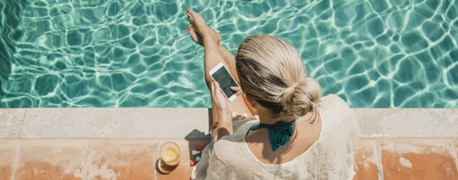How Unfenced or Poorly Fenced Pools Lead to Deadly Hazards

When a child drowns or nearly drowns at an apartment complex, hotel, or resort pool, families are left devastated—not just by grief, but by the betrayal of trust. These tragedies don’t happen in a private backyard. They happen in places that invite the public in and are supposed to be safe.
They happen in someone else’s pool. And they’re preventable.
What the Research Says About Fencing and Drowning
For decades, research has shown one thing consistently: pool fencing saves lives. The most effective kind is four-sided "isolation" fencing, which completely surrounds the pool and separates it from homes, buildings, or public areas. Three-sided fencing, where a building forms one side of the barrier, is far less effective.
A Cochrane review of multiple studies found that children are 73% less likely to drown in pools with isolation fencing. A 2000 study from Los Angeles County revealed that most child drownings occurred at pools covered by fencing laws—laws that allowed three-sided fencing and suffered from poor enforcement. A 2025 study confirmed that child drowning rates fall in areas where four-sided fencing is both mandated and enforced.
The science is clear. The real failure is in implementation.
When the Pool Is Public, the Responsibility Is Private
Parents often know to fence backyard pools. But when pools are located at hotels, apartment complexes, or water parks, the responsibility falls on someone else.
Property owners and managers have a duty to protect against foreseeable dangers, especially those involving children. Inviting families to swim means accepting the obligation to make the pool area safe.
A fence alone is not enough. It must be tall, gap-free, and built with a self-closing, self-latching gate that locks beyond the reach of small children. Anything less leaves a dangerous opening—literally and legally.
When that duty is ignored and a child is injured or killed, responsibility should fall squarely on the party who failed to act.
Many semi-public pools do not meet modern safety standards. We’ve seen:
- Gates that don’t latch
- Fences that are too low
- Three-sided barriers
- Broken or missing locks
- Fences designed in ways that allow children to climb over or crawl under
Sometimes the fence was never properly installed. Other times it was damaged and never fixed. In many cases, the person responsible either underestimated the risk—or ignored it.
That’s not an unfortunate oversight. It’s negligence.
The Stakes of a Pool Drowning Accident
When a child suffers a drowning or near-drowning, the effects are permanent.
Some children survive but with irreversible brain damage. Others do not survive at all. The grief, the medical expenses, and the questions that follow change a family forever.
In most of these cases, families had every reason to believe the pool was secure. The assumption was that someone had taken responsibility.
In truth, these tragedies are not the result of parental failure. They are the outcome of institutional neglect. The people tasked with managing the pool had the opportunity to implement well-established safety practices. They had access to decades of research. They had the duty to act.
Failing to do so is more than a missed step. It’s a conscious decision to ignore risk—and it comes with consequences.
What the Law Says
In most states, premises liability law requires property owners and managers to maintain safe conditions on their property. Pools, classified as "attractive nuisances," pose a known hazard to children and must be properly secured.
That means even if a child enters without permission, the owner still has a responsibility to anticipate and prevent access. Safety standards are not ambiguous. Organizations like the American Academy of Pediatrics and the CDC recommend four-sided fencing, at least four feet tall, with a self-closing gate.
In areas with laws requiring isolation fencing, noncompliance is illegal. But in many jurisdictions, the laws themselves fall short—either because they aren't enforced or fail to require the safeguards that make the most difference. Weak rules and poor oversight allow dangerous conditions to persist.
This is why responsibility must extend beyond minimum legal standards. Pool owners and managers have a duty to act on what the evidence makes plain: unclimbable isolation fencing with self-locking latches prevents child deaths. Failing to meet that standard is neglect, regardless of what the law might require in one county or another.
What Justice Looks Like
Families who lose a child to drowning often say: "We just want to make sure this doesn’t happen to anyone else."
Preventing future harm requires holding decision-makers accountable. Legal action isn’t just about compensation. It’s about uncovering neglect, proving that safety cannot be optional, and compelling change.
At Arnold & Itkin, we’ve represented families in lawsuits against apartment complexes, hotel chains, property managers, and pool contractors who failed to protect children. In these cases, it’s our goal to go beyond a verdict or settlement—we push for real change that ensures it never happens again.
A Tragedy That Should Never Be Repeated
Child drownings at pools managed by third parties are not isolated incidents. They are system-level failures—failures to act on known risks, to follow proven guidelines, and to prioritize life over liability.
Every incident represents a preventable loss, a devastated family, and a broken safety system. These tragedies happen in places where vigilance should be standard. Open gates and ineffective fences are inexcusable.
Laws can provide a path toward accountability, but only when they're enforced. Pool managers who ignore the basics of fencing and safety must not be shielded by complacency or vague regulations.
Preventable child deaths at public and semi-public pools demand more than sympathy. They demand standards. They demand action. No child should die for lack of a latch—and no family should have to endure the cost of someone else’s negligence.


